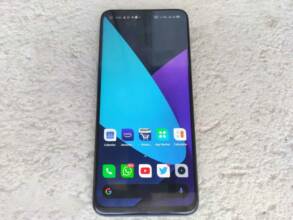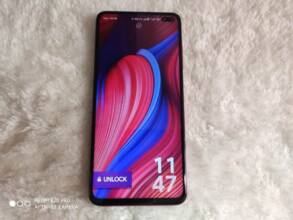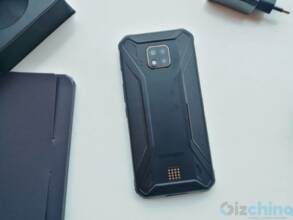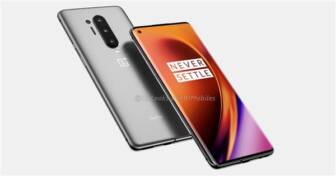Voyo VBook V3 Review: One of the first Apollo Lake devices from China
Voyo’s first VBook was a hit. Back then, 2cm bezels were a lot more common and less of an issue so even though the bezels were a little larger than usual for the time, no one paid much attention. It boasted great build quality, decent specs (the Z8300) and a large battery, all for a decent price.
What they do is quite a cost efficient measure, keep the shell of the laptop the same and update the internals. They have sold different models of the Voyo VBook V3 with the Core M 6y30 processor, and now have done the same thing with the new Apollo Lake Pentium N4200, a refreshing change from the usual Atom devices.
Voyo VBook V3 Review

While the shell of this laptop stays exactly the same as previous iterations, there are a couple more changes to the internals of the device. First, the battery has been bumped up a nice 20% and there is now an SSD in addition to an eMMC drive, which has not been done before. The price has also gone up, sitting at a pretty $420USD, which is now a pretty penny away from the Atom version. Even if the laptop is good, the processing power would have to be a massive improvement to justify the price bump. Thus, in order for this to be a good buy, one of two things (or both) have to happen; first, the processing power has to somehow match a Core M device in basic tasks at least, or the laptop has to take a huge price cut. And if both happen, then more power to the people. Let’s see how well this laptop does.
“Same outsides, new insides”
Voyo VBook V3 Specifications
| Processor | Intel Apollo Lake Pentium N4200 |
| Display | 13.3″ 1920×1080 px, touchscreen |
| RAM | 4GB |
| Storage | 128GB M.2 SSD + 32GB eMMC |
| Operating System | Windows 10 |
| Cameras | 2MP Camera |
| Battery | 12000mAh |
| Physical Properties | 1.5kg, 33.00 x 22.00 x 1.60 cm |
Big thanks to Gearbest for providing this review unit.
Voyo VBook V3 Hardware

Voyo did not design the shell of this laptop but rather purchased it from an ODM (Original Design Manufacturer). This is why every single V3 ever released (Bay Trail, Cherry Trail, Core M, Apollo Lake) uses the same externals with different internals. I am a huge fan of the soft touch rubber used on the outside. Yes, it’s not aluminum like my Xiaomi Air 12 but the rubber definitely does not exude a cheap feel. Only the brown colour was available, and while it is drab to say the least, the colour and logo strongly resemble older Dell laptops from yonder.


The V3 has two USB ports, an SD card slot as well as a mini HDMI port. I do wish for a full size HDMI port but that doesn’t always happen.
You also find volume and power buttons on the left side similar to what you would find on a tablet, most likely for use in tablet mode. There is also a key to lock the keyboard as well.

Opening the lid is incredibly hard even with two hands, which is mostly a good thing, I think we all would rather have an overtly stiff hinge instead of an overtly lax one.
While it’s not a deal breaker that Voyo used the exact same design as in previous versions of the V3, I do wish they chose a new design with smaller bezels. The bezels on this are huge. With Macbooks, Dells, and even Xiaomis utilizing tiny bezels, large bezels like these are inexcusable.
Even the newly released Chuwi Lapbook has 8mm bezels. You can rotate the screen all the way around but for myself it’s a gimmick. If you frequent planes or schools I suspect this might be a useful feature for you though.
The power and volume buttons are on the left side and just below that is the keyboard lock switch. I found myself frequently pressing the power button accidentally while I was trying to lock the keyboard, a minor annoyance.
The biggest (pun intended) complaint I have with this device are the bezels. They are unsightly and detract from the looks of this device. But other than that, the V3 is still a well made and respectable device.
“Large bezels”
Voyo VBook V3 Input
I figured I would dedicate an entire section to interacting with the laptop itself because there are enough methods of interaction that cramming them all into the build quality section up above would make it too unwieldy.
Here we have four ways to interact with the device, there is the keyboard, trackpad, touchscreen, as well as the included stylus.

The chiclet style keys on the keyboard do feel a tad cheap having just moved from my Xiaomi Air 12. I have slight difficulty depressing the keys especially with my right hand as I recently injured my wrist. That being said, the resistance is welcome as I found my Xiaomi’s keys a little too easy to depress resulting in the occasional mistype.
The trackpad was satisfactory but not impressive. Sizewise the trackpad could do with being larger, but even with the smaller size inadvertent triggers with my wrist were common while typing, there is no palm rejection software here. Single finger speed and accuracy are great, there are no complaints there. Two finger scrolling actually works quite well, but it occasionally mistakes two finger scrolls with one finger input, so your scrolling might stop inadvertently, but that isn’t a big issue.
Windows gestures don’t seem to be working either but that isn’t a big issue and is actually a welcome subtraction.
 The touchscreen is decent. The level of touch sensitivity is definitely more than enough, but it falls behind the sensitivity on an iPad or Surface. That being said, it’s still a great (and in some cases a better) option for interacting with browsers.
The touchscreen is decent. The level of touch sensitivity is definitely more than enough, but it falls behind the sensitivity on an iPad or Surface. That being said, it’s still a great (and in some cases a better) option for interacting with browsers.
There is also an included pen that charges via USB and each charge yields around 4 hours of use. However, the pen experience is not very good. I tried using it to write in Onenote, and there is no pressure sensitivity and there is a tiny bit of lag compared to active styli.
That’s not the worst part though. the worst part is how far the pen needs to be lifted away before it “deactivates”. You need to move the tip of the pen at least 1cm away from the screen before the pen deactivates completely and if you don’t, you look like a 3rd grader practicing cursive for the “most improved” award. however, if you are used to writing in cursive, then this pen is perfect for you.
Voyo VBook V3 Display
The 1080p resolution on the 13.3” definitely looks nice, colours are reproduced nicely and there is quite a bit of contrast. The screen is a slight bit on the blue side, but this won’t affect anyone at all unless you’re doing some serious colour grading (which you could not perform effectively on a Pentium).
The max brightness of the screen goes up to around 300 nits which is definitely acceptable for a laptop, you still cannot use it in bright sunlight but it is possible to use it outdoors on a cloudy day.
The display does excel in terms of colour reproduction and contrast.
Voyo VBook V3 Audio
We have downward firing speakers and its definitely not the most ideal place for laptop speakers. It is easily muffled if used on your lap and is difficult to hear. However, even on a hard surface, maximum volume isn’t the loudest. It has difficulty matching up to my Xiaomi Air 12 but is still loud enough for moderately loud environments.
Audio quality is a mixed bag, while you have decent mids and highs (no they are in no way great), there is some bass for TV shows and movies, however explosion heavy movies are not a very good experience, so you can go ahead and count every single Michael Bay movie out for the count.
Voyo VBook V3 Battery
Voyo has wisely bumped up the battery capacity from 10,000mAh to 12,000mAh, a nice 20% bump from the original. However, even with this battery increase, I do not expect better battery life than Atoms as it has a 6W TDP while Atoms have miserly 2W TDPs. A good reference is the Xiaomi Air 12, which has a 10,000mAh battery and the Core M 6y30 with a 7W TDP (around 7 hours of battery life).
The new Apollo Lake processors are also a lot less bursty which would also mean reduced battery life.
The results are somewhat within my expectations, I was expecting about the same battery life as the Atom version of this laptop (around 8-9 hours of use) and I got slightly less than that. The 8 hours of screen on time consisted of web browsing, word documents, and email, so nothing intense. I did play a couple of YouTube videos though (not 2K or 4K).
I performed some battery tests and was able to obtain about 8 hours and 20 minutes of video playback , a good result here but not the best. Web browsing saw a lower battery score with continuous browsing draining the battery in about 7:21, still a decent result here.
The battery results were somewhat within my expectations, there is a bigger battery, but there is also a more power hungry CPU, so I wasn’t expecting any huge jump in battery life. It takes about 2.5-3 hours to charge this laptop up completely.
“Decent battery”
Voyo VBook V3 Software
Hmm, performance, what to expect. The new Intel Apollo Lake chips are so new that there are at most 3-4 products currently released using said line of chips. Performance wise they squeeze exactly between the Atom chips and Core M chips with performance of the N4200 trending slightly closer to the Core M. We already know how previous generation Celeron chips perform, so let’s see how much the new Apollo Lake architecture improves performance.

Let’s first talk about general use before we move on to benchmarks. Opening and closing light Windows store apps as well as light desktop programs is on par with my Core M Xiaomi Air 12 which is definitely a huge upside for this device. That being said though, a Cherry Trail Atom does not necessarily lag when doing the above items either, but there is a noticeable speed difference between the N4200/Core M vs Cherry Trail devices. A good analogy would be like comparing a Snapdragon 821 to a Snapdragon 625. The Snapdragon 625 does not lag, but the 821 will open apps that much faster.
There is a Foresee M.2 SSD and an eMMC drive as well, I got quite decent speeds, and the SSD definitely contributed to the snappiness I felt while using it. There is also an extra slot for another M.2 SSD, which is an upgradeability option I was not expecting from something so cheap. The N4200 still falls behind in one regard though, and that would be Chrome. It is still slightly laggier compared to Edge and cannot play back 2K or 4K videos smoothly when the exact same video plays back perfectly in Edge.
Now for (in my opinion) the most impressive part. I was able to GIMP (Photoshop) quite effectively, doing anything that did not involve applying filters (which is CPU intensive) was quick. And I was editing a DSLR photo as well. Now before you go on to the next paragraph, here’s part two of “the most impressive part”. I was able to edit 1080p video quite effectively using Da Vinci Resolve, which is a free video editing program that is slightly less fleshed out than Premiere but still more than enough for someone like me. Now keep in mind that exporting said video took me about 4-5 times as long as my gaming desktop, but the fact that a Pentium chip can edit basic 1080p video sent a shiver up my spine. Does that mean I will have no reason to upgrade my desktop? Nope I’ll definitely be upgrading it, I need an excuse to buy the latest and greatest in computer hardware.
I tried to game on the laptop and was slightly surprised by the results. I could play DOTA2 at 1080p with about 30fps on lowest settings which is impressive considering every Atom device could only crank out 30fps at 720p. I then tried Call of Duty: Modern Warfare 3 and I was able to get around 25-30fps at 720p which was nice. I was actually able to get around 21-27fps in 1080p in similar situations meaning a smaller than expected performance hit. And finally Skyrim was playable at 30fps 720p on lowest settings as well. Do note that the gameplay portions of the video look significantly laggier than what you would expect from the aforementioned framerates because I had FRAPS enabled which takes a good 5-8fps from the total framerate. The laptop does get warm quite easily when gaming but the surface temps on the laptop never got hot enough for discomfort. Most of the heat is concentrated around the 360 hinges with almost no heat on the surfaces near the keyboard. Benchmarks. I only ran a couple of them because I’m lazy, but here we have it. First is Cinebench, which is a CPU and GPU test, and it gets a score of 9.33fps and 125 cb, which is definitely a lot more than what an Atom processor (around 50-60cb) is able to get, but it still trails behind Core M processors (even those two generations old, which ranges from 180-220).
Benchmarks. I only ran a couple of them because I’m lazy, but here we have it. First is Cinebench, which is a CPU and GPU test, and it gets a score of 9.33fps and 125 cb, which is definitely a lot more than what an Atom processor (around 50-60cb) is able to get, but it still trails behind Core M processors (even those two generations old, which ranges from 180-220). Geekbench also tests both your CPU and GPU and it gets very respectable scores, 1600 for single core performance and 3570 for multicore performance. That’s more than double what a Cherry Trail Atom obtains in both single and multicore (740/1430) performance. It still falls behind the Core M 6y30 though, trailing about 20-30% behind (2156/4249).
Geekbench also tests both your CPU and GPU and it gets very respectable scores, 1600 for single core performance and 3570 for multicore performance. That’s more than double what a Cherry Trail Atom obtains in both single and multicore (740/1430) performance. It still falls behind the Core M 6y30 though, trailing about 20-30% behind (2156/4249).

The final benchmark I ran was Octane which is a browser based benchmark. It got around 8900 in Chrome which is not bad, getting around double what an Atom processor would score. It does fall quite far behind the 6y30 though which scored almost 20,000 in Chrome.
I’m quite satisfied and somewhat impressed by overall performance. Software like GIMP and Da Vinci impressed me with the speed with which photo and video editing took place. However, I was slightly disappointed with the gaming results, I was expecting to be able to play something like DOTA2 at higher framerates at 1080p, but 30fps is still a playable framerate.
Voyo VBook V3 Connectivity

Both USB ports are capable of powering hard drives, charging phones, and the like. WiFi performance is weaker than usual, it struggles to get good speeds two floors above my router. Bluetooth range works fine. The webcam is just a 480p webcam, and as the internet likes to call it, it’s basically a potato.
Voyo VBook V3 Verdict
The Voyo VBook V3 is expensive, or at least the Pentium version is compared to certain Atom devices you can get nowadays (like the EZBook 2). With that increased expense you do get a much more powerful processor and a bigger battery, but that’s about it. You also get the strange combination of an M.2 SSD and an eMMC drive, as well. However, everything else stays the same.
I really don’t know if this laptop is worth the $400, even though the N4200 CPU does give a vastly improved experience, on par with Core M laptops in light use. And the reason why I’m hesitant to endorse this product as something that is “worth it” is because Core M laptops that have been out for a while regularly go on sale or have permanent price cuts.
You can purchase Cube tablets with Core M CPUs for $300 if you’re lucky, with $450 regularly seen. What’s ironic is that the Core M version of the Voyo VBook V3 can be had for $387 right now, a good $50 cheaper than original price of the N4200 version! I don’t envision these Pentium/Celeron devices maintaining their prices for very long and as time goes on the prices will start getting slashed, and this Pentium laptop will fit nicely into the niche between the Core M and Cherry Trail devices.
“An expensive starting price”
You can buy the Voyo VBook V3 here. The original price is around $420 but it’s currently on flash sale for $359.
Voyo VBook V3 Video Review
[embedded content]
Voyo VBook V3 Gallery
- Build Quality – 71%
- Display – 73%
- Audio – 70%
- Battery – 73%
- Software & Performance – 86%
- Connectivity – 88%
76.8 %







